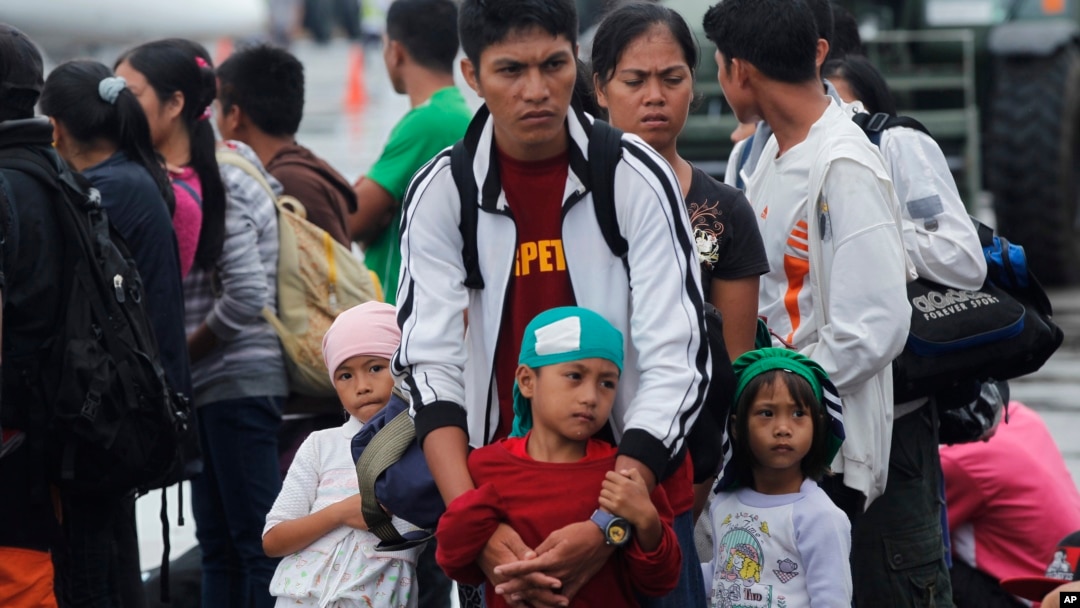MANILA —
Two weeks after Super Typhoon Haiyan carved a path of destruction across the central Philippines, health officials are set to vaccinate one million children in the coming weeks.
More than 5,000 people perished in one of the most powerful cyclones recorded. Another 4.3 million people were left homeless by Haiyan. Close to 10 percent of them are staying in evacuation centers. And health officials are especially concerned about large groups of displaced people clustered together.
Dr. Sigrun Roesel and other officials with the World Health Organization told reporters in Manila children are particularly vulnerable to highly contagious illnesses.
“We all are aware how many people have died in the disaster and it is now of utmost importance that we prevent more death to happen,” Roesel said.
Health officials say in the typhoon-affected part of the country there are more than 320,000 children below the age of five.
The Philippine Health Department and the WHO are coordinating teams to give children measles shots, polio vaccinations and vitamin A. Officials emphasize there are no polio cases in the country. However, they want to take preventive measures because a number of international travelers are visiting the typhoon area. They say vitamin A is being included to help address malnutrition.
WHO Country Representative Dr. Julie Hall said there are some cases of measles in the Philippines.
“This is one of the poorest parts of the Philippines that’s been hit by the typhoon. So those children we could expect, if there was a measles outbreak, for it to spread fairly quickly.," she explained. "And unfortunately we would then see quite a number of deaths from children but also damage- brain damage, hearing damage, other damage to the children.
Dr. Hall said apart from measles, health workers are also on alert for any spike in diarrhea and vomiting because of dirty water. She said mosquito-borne diseases like dengue and malaria are also a concern.
The Department of Health says more than 1,100 clinics and about 80 hospitals were partially damaged or destroyed by Haiyan.
Health Department Secretary Dr. Enrique Ona said 24,000 births are expected in the typhoon-battered provinces over the next month.
“It’s very important for us to, as fast as possible, make sure that our rural health units in particular with delivery facilities be put in place right away because this is where most of our poor mothers deliver,” he said.
The Health Department is also keeping an eye on micro-organisms that may fester from the corpses that had been decaying for longer than a week in and around Tacloban. The typhoon whipped up a powerful storm surge that left bodies strewn about in that city.
The WHO says about 1,200 medical personnel both local and international have fanned out across the affected area.
More than 5,000 people perished in one of the most powerful cyclones recorded. Another 4.3 million people were left homeless by Haiyan. Close to 10 percent of them are staying in evacuation centers. And health officials are especially concerned about large groups of displaced people clustered together.
Dr. Sigrun Roesel and other officials with the World Health Organization told reporters in Manila children are particularly vulnerable to highly contagious illnesses.
“We all are aware how many people have died in the disaster and it is now of utmost importance that we prevent more death to happen,” Roesel said.
Health officials say in the typhoon-affected part of the country there are more than 320,000 children below the age of five.
The Philippine Health Department and the WHO are coordinating teams to give children measles shots, polio vaccinations and vitamin A. Officials emphasize there are no polio cases in the country. However, they want to take preventive measures because a number of international travelers are visiting the typhoon area. They say vitamin A is being included to help address malnutrition.
WHO Country Representative Dr. Julie Hall said there are some cases of measles in the Philippines.
“This is one of the poorest parts of the Philippines that’s been hit by the typhoon. So those children we could expect, if there was a measles outbreak, for it to spread fairly quickly.," she explained. "And unfortunately we would then see quite a number of deaths from children but also damage- brain damage, hearing damage, other damage to the children.
Dr. Hall said apart from measles, health workers are also on alert for any spike in diarrhea and vomiting because of dirty water. She said mosquito-borne diseases like dengue and malaria are also a concern.
The Department of Health says more than 1,100 clinics and about 80 hospitals were partially damaged or destroyed by Haiyan.
Health Department Secretary Dr. Enrique Ona said 24,000 births are expected in the typhoon-battered provinces over the next month.
“It’s very important for us to, as fast as possible, make sure that our rural health units in particular with delivery facilities be put in place right away because this is where most of our poor mothers deliver,” he said.
The Health Department is also keeping an eye on micro-organisms that may fester from the corpses that had been decaying for longer than a week in and around Tacloban. The typhoon whipped up a powerful storm surge that left bodies strewn about in that city.
The WHO says about 1,200 medical personnel both local and international have fanned out across the affected area.


